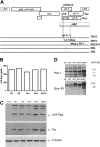Requirement of the human T-cell leukemia virus p12 and p30 products for infectivity of human dendritic cells and macaques but not rabbits
- PMID: 20647569
- PMCID: PMC2981536
- DOI: 10.1182/blood-2010-05-284141
Requirement of the human T-cell leukemia virus p12 and p30 products for infectivity of human dendritic cells and macaques but not rabbits
Abstract
The identification of the genes necessary for human T-cell leukemia virus (HTLV-1) persistence in humans may provide targets for therapeutic approaches. We demonstrate that ablation of the HTLV-1 genes encoding p12, p30, or the HBZ protein, does not affect viral infectivity in rabbits and in this species, only the absence of HBZ is associated with a consistent reduction in virus levels. We observed reversion of the HTLV-1 mutants to the HTLV-1 wild-type genotype in none of the inoculated rabbits. In contrast, in macaques, the absence of HBZ was associated with reversion of the mutant virus to the wild-type genotype in 3 of the 4 animals within weeks from infection. Similarly, reversion to the wild type was observed in 2 of the 4 macaque inoculated with the p30 mutant. The 4 macaques exposed to the p12 knock remained seronegative, and only 2 animals were positive at a single time point for viral DNA in tissues. Interestingly, we found that the p12 and the p30 mutants were also severely impaired in their ability to replicate in human dendritic cells. These data suggest that infection of dendritic cells may be required for the establishment and maintenance of HTLV-1 infection in primate species.
Figures






Similar articles
-
Human T-cell lymphotropic virus type 1 open reading frame II-encoded p30II is required for in vivo replication: evidence of in vivo reversion.J Virol. 2004 Apr;78(8):3837-45. doi: 10.1128/jvi.78.8.3837-3845.2004. J Virol. 2004. PMID: 15047799 Free PMC article.
-
In vitro and in vivo functional analysis of human T cell lymphotropic virus type 1 pX open reading frames I and II.AIDS Res Hum Retroviruses. 2000 Nov 1;16(16):1757-64. doi: 10.1089/08892220050193272. AIDS Res Hum Retroviruses. 2000. PMID: 11080823
-
Enhancement of infectivity and persistence in vivo by HBZ, a natural antisense coded protein of HTLV-1.Blood. 2006 May 15;107(10):3976-82. doi: 10.1182/blood-2005-11-4551. Epub 2006 Jan 19. Blood. 2006. PMID: 16424388 Free PMC article.
-
p30 protein: a critical regulator of HTLV-1 viral latency and host immunity.Retrovirology. 2019 Dec 18;16(1):42. doi: 10.1186/s12977-019-0501-2. Retrovirology. 2019. PMID: 31852501 Free PMC article. Review.
-
[Adult T-cell leukemia induced by HTLV-1: before and after HBZ].Med Sci (Paris). 2010 Apr;26(4):391-6. doi: 10.1051/medsci/2010264391. Med Sci (Paris). 2010. PMID: 20412744 Review. French.
Cited by
-
Molecular and Cellular Mechanism of Leukemogenesis of ATL: Emergent Evidence of a Significant Role for HBZ in HTLV-1-Induced Pathogenesis.Leuk Res Treatment. 2012;2012:213653. doi: 10.1155/2012/213653. Epub 2011 Nov 24. Leuk Res Treatment. 2012. PMID: 23198153 Free PMC article.
-
Molecular epidemiology, genetic variability and evolution of HTLV-1 with special emphasis on African genotypes.Retrovirology. 2019 Dec 16;16(1):39. doi: 10.1186/s12977-019-0504-z. Retrovirology. 2019. PMID: 31842895 Free PMC article. Review.
-
Human T-lymphotropic virus type 1 p30 interacts with REGgamma and modulates ATM (ataxia telangiectasia mutated) to promote cell survival.J Biol Chem. 2011 Mar 4;286(9):7661-8. doi: 10.1074/jbc.M110.176354. Epub 2011 Jan 7. J Biol Chem. 2011. PMID: 21216954 Free PMC article.
-
The human T-cell leukemia virus type-1 p30II protein activates p53 and induces the TIGAR and suppresses oncogene-induced oxidative stress during viral carcinogenesis.Virology. 2018 May;518:103-115. doi: 10.1016/j.virol.2018.02.010. Epub 2018 Feb 20. Virology. 2018. PMID: 29462755 Free PMC article.
-
Transfer of HTLV-1 p8 and Gag to target T-cells depends on VASP, a novel interaction partner of p8.PLoS Pathog. 2020 Sep 30;16(9):e1008879. doi: 10.1371/journal.ppat.1008879. eCollection 2020 Sep. PLoS Pathog. 2020. PMID: 32997728 Free PMC article.
References
-
- Gessain A, Barin F, Vernant J-C, et al. Antibodies to human T-lymphotropic virus type I in patients with tropical spastic paraparesis. Lancet. 1985;2(8452):407–410. - PubMed
-
- Lairmore MD, Franchini G. Human T-cell leukemia/lymphoma virus types 1 and 2. In: Knipe DM, Howley PM, editors. Fields Virology. 5th ed. Philadelphia, PA: Lippincott Williams & Wilkins; 2007. pp. 2071–2106.
Publication types
MeSH terms
Substances
Grants and funding
LinkOut - more resources
Full Text Sources
Other Literature Sources
Miscellaneous

